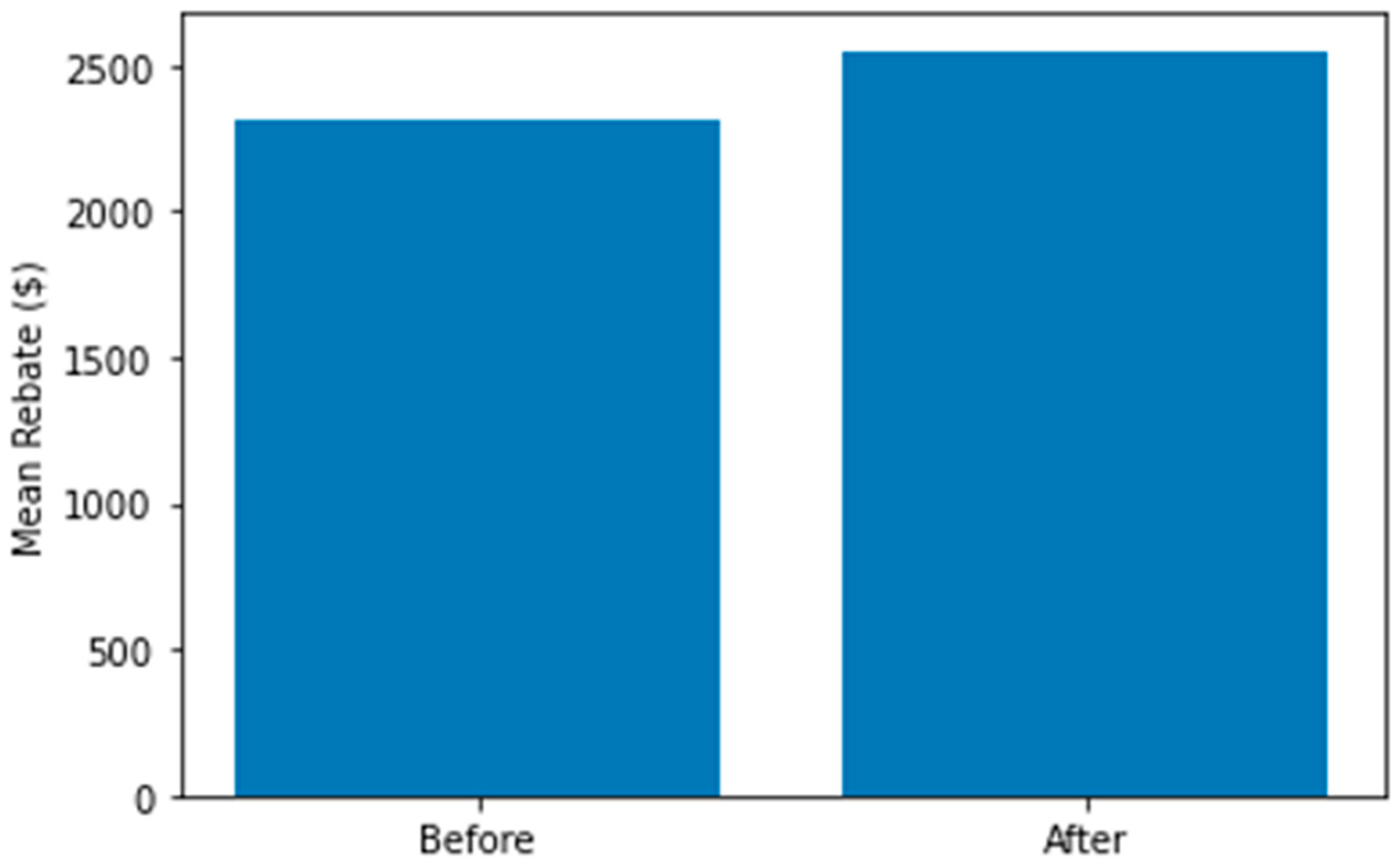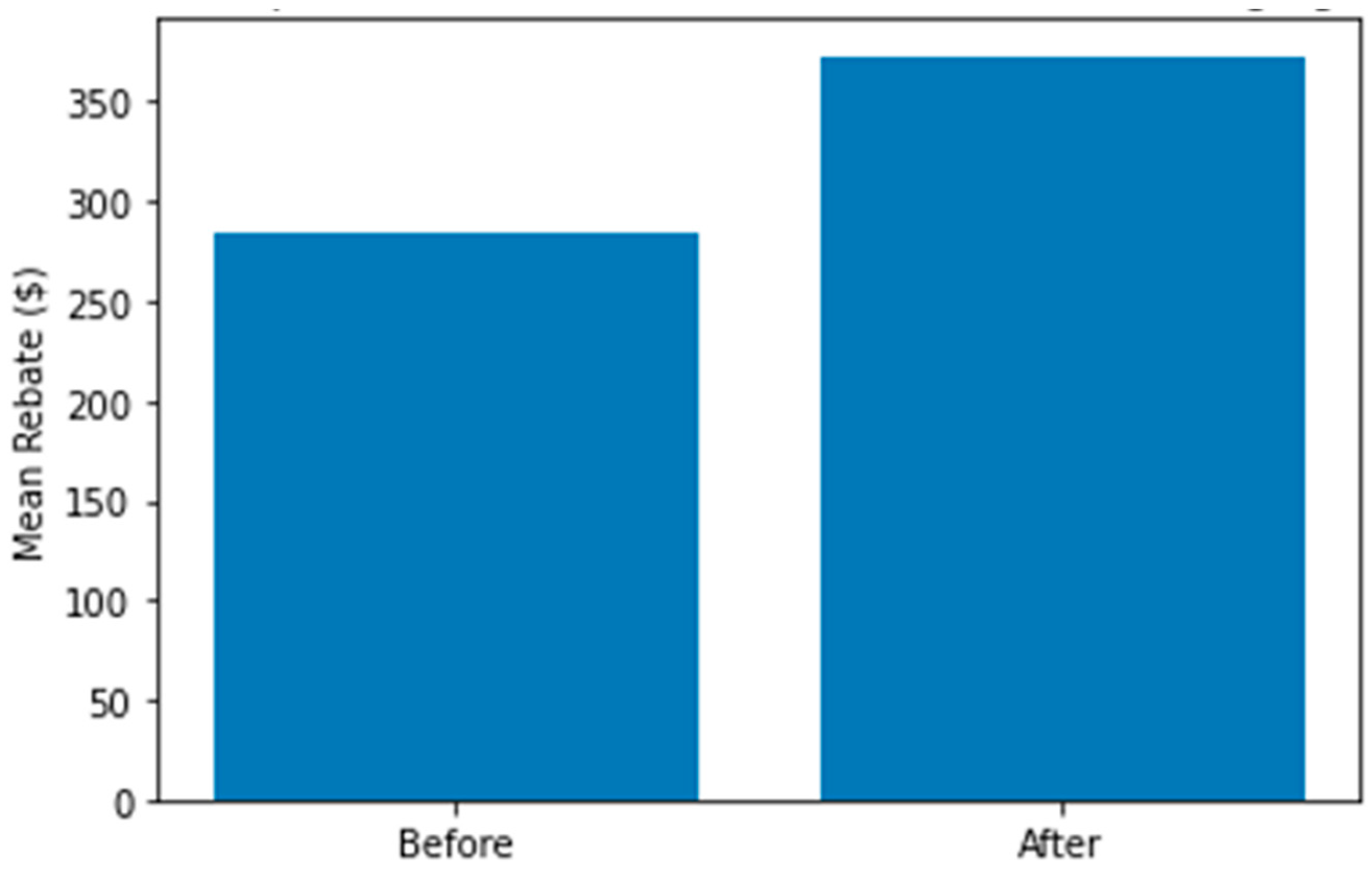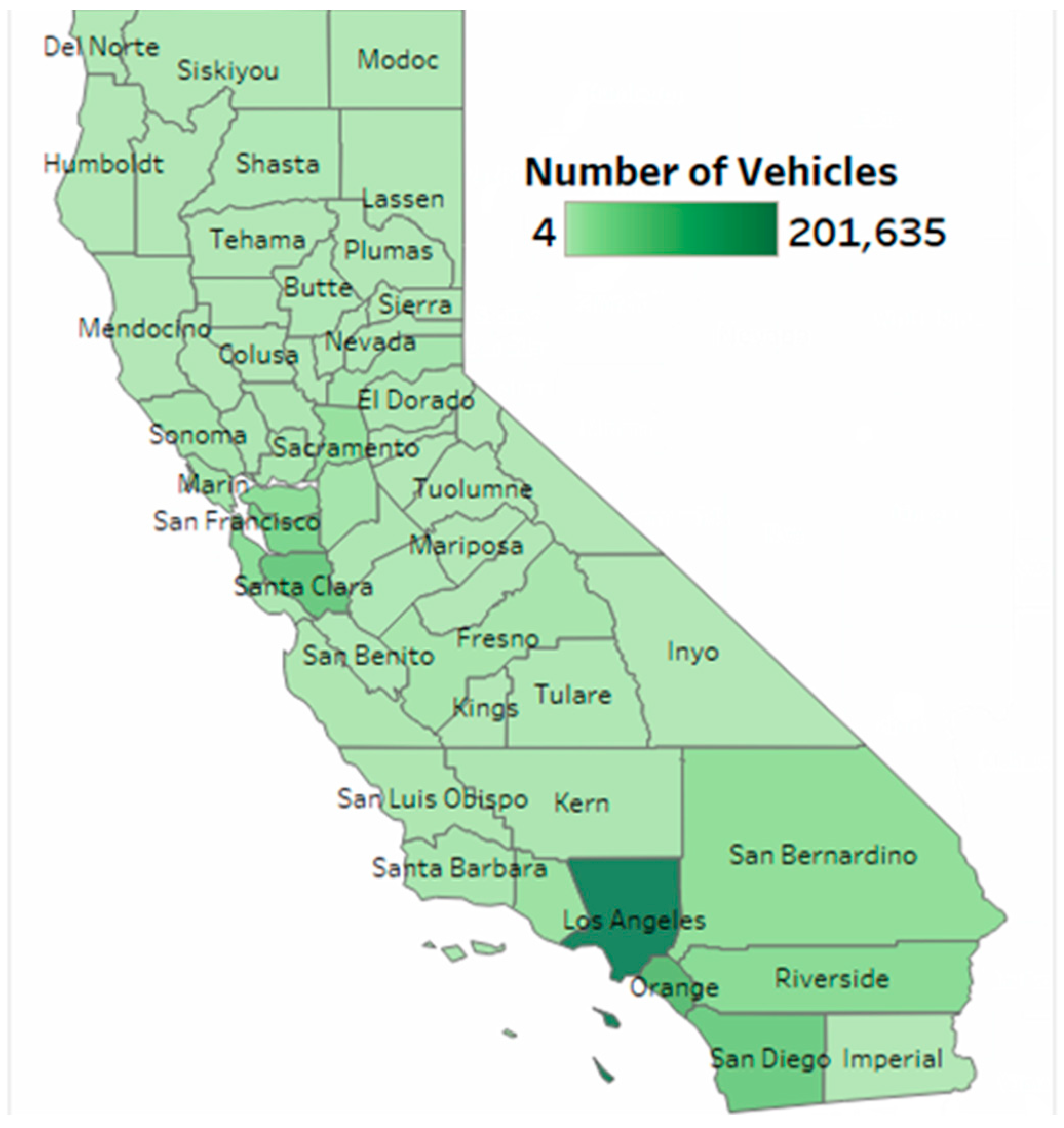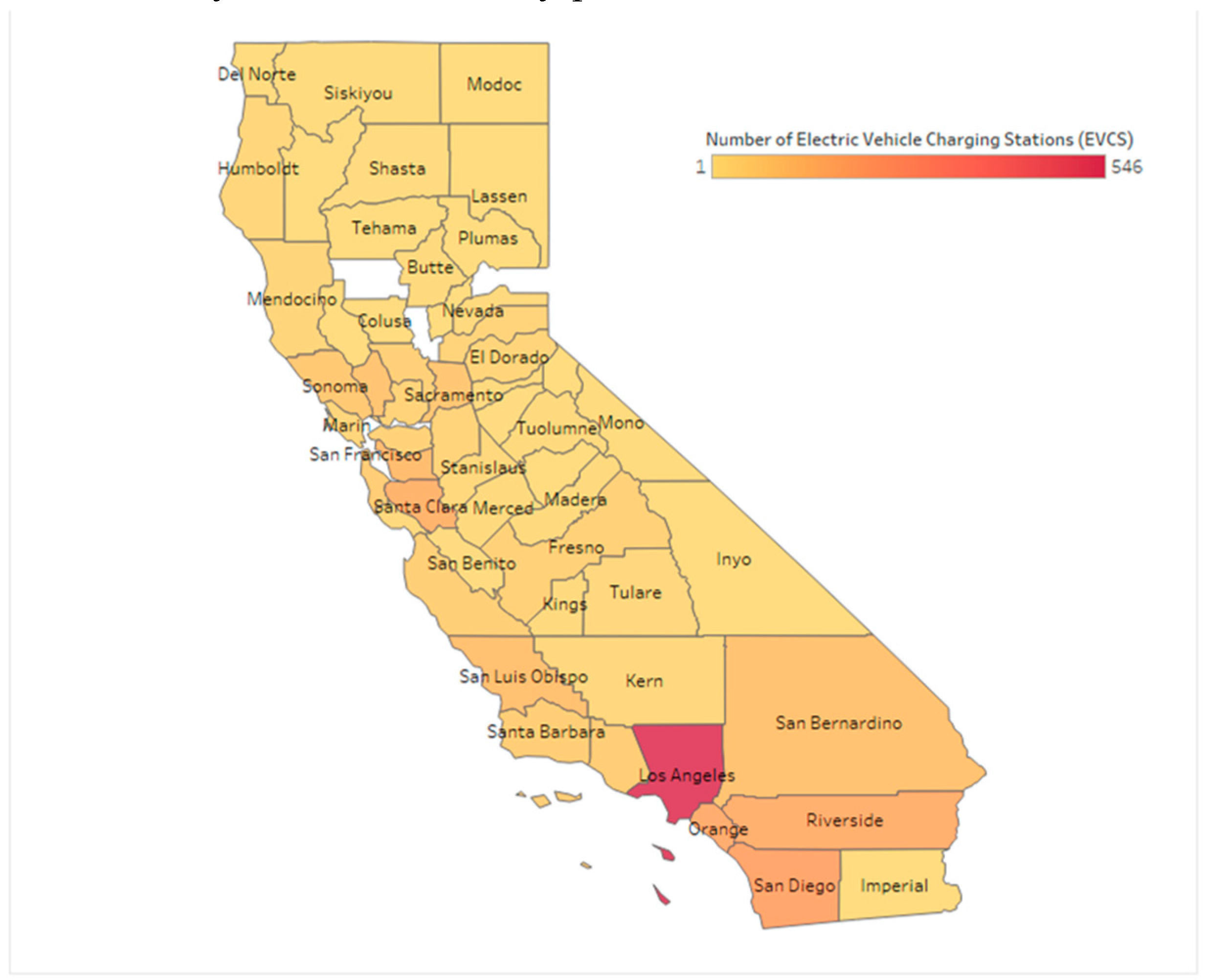Submitted:
27 October 2023
Posted:
30 October 2023
Read the latest preprint version here
Abstract
Keywords:
1. Introduction
- Are local EV adoption rates and rebate applications correlated with the installation of public EV chargers?
- If there is a correlation, what is the quantitative relationship between the installation of charging stations and changes in EV sales or rebate application rates?
- Does this relationship vary based on community characteristics such as commute distance, housing density, or income level?
1.1. Factors that Affect EV Adoption
- Manufacturing Factors: These factors affect the EV industry, including incentives and charging infrastructure. [2]
| Title 1 | Level 1 | Level 2 | DC Fast Charging |
|---|---|---|---|
| Connector Type | CCS/SAE connector | ||
| J1772 connector | J1772 connector | CHAdeMO connector | |
| Tesla connector | Tesla connector | ||
| Typical Power Output | 1 kW | 7 kW-19 kW | 50-350 kW |
| Estimated PHEV Charge Time from Empty | 5-6 hours | 1-2 hours | N/A |
| Estimated BEV Charge Time from Empty | 40-50 hours | 4-10 hours | 20 minutes-1 hours |
| Typical Locations | Home | Home, Workplace, | Public |
| and Public |
- 2.
- The personal/driver factors include the range, charging speed, the awareness and desire of the driver to adopt an EV, cost, and incentives or rebates available for the purchase. One important factor in determining the purchase of an EV is its range, that is, the ability to travel farther on a charge. Over the past decade, battery technology has improved EV ranges. Three electric vehicle charging speeds are currently available in the USA, which are level 1, the slowest, and providing charging through a standard residential 120-volt AC outlet. The level 2 equipment offers charging through 240V or 280V, and the Direct Current Fast Charging (DCFC) has the fastest charging speed. Other variables that affect EV ranges, such as weather, at a temperature below 200 F, can cause EVs to lose around 12% of their range, rising to 41 % if heating is turned on inside the vehicle [3]. Another important factor is the cost which is represented as the Manufacturer's Suggested Retail Price (MSRP)
| Year | Avg. EV Range | Maximum EV Range | Average MSRP |
|---|---|---|---|
| 2010 | 79 miles (127 km) | N/A | N/A |
| 2011 | 86 miles (138 km) | 94 miles (151 km) | N/A |
| 2012 | 99 miles (159 km) | 265 miles (426 km) | N/A |
| 2013 | 117 miles (188 km) | 265 miles (426 km) | N/A |
| 2014 | 130 miles (209 km) | 265 miles (426 km) | N/A |
| 2015 | 131 miles (211 km) | 270 miles (435 km) | N/A |
| 2016 | 145 miles (233 km) | 315 miles (507 km) | $33,380 |
| 2017 | 151 miles (243 km) | 335 miles (539 km) | $58,965 |
| 2018 | 189 miles (304 km) | 335 miles (539 km) | $64,300 |
| 2019 | 209 miles (336 km) | 370 miles (595 km) | $55,600 |
| 2020 | 210 miles (338 km) | 402 miles (647 km) | $54,668 |
| 2021 | 217miles (349 km) | 520 miles (837 km) | $64,249 |
| 2022 | 211 miles (341 km) | 520 miles (837 km) | $65,291 |
- 3.
- Environmental and External Factors: to establish net-zero emissions by 2050, the need for EV adoption is ever-increasing with the rising gas price.
1.2. Qualitative Characteristics
1.3. Quantitative Characteristics
- Changes to the temperature rise test to include additional points of measurement.
- Additional tests for accessories to address thermal stress and stability, mechanical wear and abuse, and exposure to contaminants.
- Additional requirements for contact material and plating
- Charging Cable Plug Compatibility: one of the major concerns for EV drivers is the compatibility of the outlet of the charging station to their respective EVs. Unlike gasoline vehicles, which have one universal outlet plug for gasoline, the EV currently has four different outlets for charging. There are two types of AC plugs (type 1 and type 2) and two types of DC plugs (CHAdeMO and CCS)
- Charging Efficiency: the amount of time it takes to charge an EV is important in determining EV adoptions and charging. The situation determines the charging efficiency for an instant. A fast-charging station of about 15-20 minutes will be required on highways and freeways, but a shop and charge may require 1 to 2 hours for a full charging process of around 22KW. And a home charger may hold up to 3.6KW power and require 6 to 8 hours for a full charging process.
- Diverse Payment Options: paying depends on the charger point operators or network for public charging stations that are not free. Many networks provide subscriptions or memberships that lower the monthly fees, and these payments are usually made through an app, fob, or an RFID card. However, almost all public charging stations have options for card payments.
- Strategic location: a strategic location is a crucial attribute in determining the reliability of an EV charging station. On average rapid chargers will take between 20-30 minutes to provide between 60-200 miles of ranges.
1.4. Role of Rebate in EV Adoption
- California's Zero Emission Vehicle (ZEV) mandate, which was adopted in 1990 and requires automakers to sell a certain number of ZEVs in California each year.
- The California Clean Vehicle Rebate Project (CVRP) offers rebates for purchasing or leasing new electric vehicles. The program began in 2010 and has undergone several rebate amounts changes.
- The California Electric Vehicle Infrastructure Project (CALeVIP), which offers incentives for the installation of EV charging stations. The program began in 2015 and has also gone through several changes in incentive amounts over the years.
2. Data and Methodology
3. Discussion
3.1. Rebate Analysis
| Methodology | Description |
|---|---|
| Data Source | California Energy Commission (CEC), California Department of Motor Vehicles, California Air Resources Board (CARB), and U.S. Census Bureau |
| Period | 2010-2022 |
| Treatment | Installation of EV charging stations |
| Control Group | N/A |
| Pre-Period | >2019 |
| Post-Period | <2019 |
| Outcome Variable | The dollar amount of the Rebate |
| t-statistics | nan |

3.2. EV Adoption Analysis
- Infrastructure Accessibility Matters: The increased adoption of electric vehicles after the installation of charging stations highlights the importance of accessibility to charging infrastructure. Consumers are more likely to embrace EVs when they have confidence in their ability to find convenient and reliable charging points.
- Reducing Range Anxiety: Charging station installations contribute to reducing "range anxiety," a common concern among potential EV adopters. Knowing that charging stations are readily available can alleviate fears of running out of power during trips, making EVs a more attractive choice for daily use and longer journeys.
- Policy Implications: Policymakers can draw significant lessons from these results. Investments in expanding the charging network can yield substantial returns in terms of increased EV adoption, aligning with California's ambitious emissions reduction goals.
- Consumer Behavior: Understanding the impact of charging infrastructure on adoption provides insights into consumer behavior. It suggests that the decision to switch to an electric vehicle is not solely based on the environmental benefits but is also influenced by practical considerations, including charging convenience.
- Future Growth: As the EV market continues to expand, the role of charging infrastructure will become increasingly critical. With ongoing technological advancements and infrastructure development, the EV adoption rate is likely to continue rising.
| Methodology | Description |
|---|---|
| Data Source | California Energy Commission (CEC), California Department of Motor Vehicles, California Air Resources Board (CARB), and U.S. Census Bureau |
| Period | 2010-2022 |
| Treatment | Installation of EV charging stations |
| Control Group | N/A |
| Pre-Period | >2019 |
| Post-Period | <2019 |
| Outcome Variable | EV adoption count |
| t-statistics | -23.89 |
| Significance Level (p-value) | 0.000 |


4. Policy Implications/Conclusion
-
Investment in Charging Infrastructure: The statistically significant increase in EV adoption after the installation of EV charging stations underscores the importance of continued investment in charging infrastructure. Policymakers should prioritize the expansion of charging networks to improve accessibility and convenience for EV owners. This includes increasing the number of charging stations in urban areas, along highways, and in public places.
- Analysis Support: The statistical analysis showed that the mean EV adoption count increased significantly from 283 to 373.02 after EVCS installation, indicating the direct impact of infrastructure accessibility on adoption.
-
Reducing Range Anxiety: One of the major barriers to EV adoption is range anxiety, the fear of running out of battery power while driving. By strategically placing charging stations, policymakers can help alleviate this concern and encourage more consumers to transition to EVs.
- Analysis Support: The significant increase in EV adoption rates can be attributed to reduced range anxiety, as consumers have more confidence in their ability to find charging stations conveniently.
-
Supporting Emission Reduction Goals: Many regions, including California, have set ambitious goals to reduce greenhouse gas emissions. The study's results suggest that promoting EV adoption through infrastructure development can contribute to achieving these targets. Policymakers should align their EV policies with broader environmental objectives.
- Analysis Support: As EVs produce lower emissions compared to traditional vehicles, the increase in EV adoption contributes to reducing overall greenhouse gas emissions.
-
Incentives and Regulations: While infrastructure expansion is crucial, policymakers should also consider a comprehensive approach that includes financial incentives, tax credits, and regulations that promote EV adoption. These measures can work in tandem with infrastructure development to drive consumer interest.
- Analysis Support: The study did not directly account for incentives and regulations, but their role in EV adoption is well-documented in the literature, and they likely interact with infrastructure availability.
-
Long-Term Planning: Policymakers should consider the long-term sustainability of charging infrastructure. This includes addressing issues related to maintenance, technology upgrades, and ensuring that charging stations remain accessible and functional over time.
- Analysis Support: While the study's data covers up to 2022, long-term planning is essential to support the continued growth of the EV market beyond the scope of this analysis.
-
Public-Private Partnerships: Collaborations between government entities and private sector stakeholders, including charging station providers and automakers, can help accelerate the deployment of EVCS. Policymakers can create a conducive environment for such partnerships.
- Analysis Support: The study's findings provide evidence that the installation of EVCS positively impacts EV adoption, making the case for continued collaboration between public and private sectors.
4.1. Future Research Directions
- Long-Term Impact: This study focused on a relatively short-term period from 2010 to 2022. Future research could explore the long-term impact of EV charging stations on EV adoption and rebates over several decades. This would provide a more comprehensive view of how charging infrastructure influences the evolution of the electric vehicle market.
- Regional Variations: California is a diverse state with varying demographics and geographic features. Future research could delve deeper into regional variations in the impact of EV charging stations on EV adoption and rebates. This would help identify areas where charging infrastructure has a more significant effect and tailor policies accordingly.
- Consumer Behavior: Understanding consumer behavior is crucial in promoting EV adoption. Future research could investigate the psychological and sociological factors that influence individuals' decisions to purchase EVs, even in the presence of charging infrastructure. This could include factors like social norms, peer influence, and perceived environmental benefits.
- Economic Analysis: A more comprehensive economic analysis could be conducted to assess the cost-effectiveness of EV charging station installations compared to other policy measures aimed at promoting EV adoption. This would help policymakers allocate resources more efficiently.
- Policy Evaluation: Evaluating the effectiveness of specific policies, such as rebate programs and incentive schemes, in conjunction with charging infrastructure expansion could provide valuable insights into the most impactful strategies for accelerating EV adoption.
- Technological Advancements: With rapid advancements in battery technology and charging infrastructure, future research should keep pace with these developments. Assessing how emerging technologies, such as fast-charging stations and higher-capacity batteries, impact EV adoption will be essential.
- Environmental Impact: While this study briefly touched on the environmental benefits of EV adoption, future research could delve deeper into quantifying the reduction in greenhouse gas emissions attributable to increased EV adoption facilitated by charging infrastructure.
- Public Perception: Understanding how the public perceives EV charging stations and their role in the transition to electric mobility is crucial. Future studies could explore public attitudes, concerns, and awareness regarding EV infrastructure.
4.1. Limitations
- Causality and Correlation: The analysis presented in this study establishes a correlation between the installation of EV charging stations and increased EV adoption. However, it does not establish causality. While the presence of charging infrastructure is associated with higher EV adoption rates, other unmeasured factors may also contribute to the observed trends.
- Data Limitations: The study relies on publicly available data sources, which may have limitations in terms of accuracy and completeness. Additionally, the data might not capture all relevant variables that could influence EV adoption, such as local economic conditions, consumer preferences, and advertising campaigns.
- Temporal Scope: The analysis covers the period from 2010 to 2022, with a post-period defined as 2019. While this choice was made to align with significant policy developments, it may not capture longer-term trends and the full impact of charging infrastructure on EV adoption.
- Regional Specificity: The study focuses on California, a state known for its strong commitment to environmental initiatives and EV adoption goals. Findings from this study may not be directly applicable to regions with different policies, economic conditions, and cultural attitudes toward EVs.
- Other Policy Factors: While this study focuses on the role of EVCS, it does not account for other policy factors, such as tax incentives, rebates, and emissions regulations, which can also influence EV adoption rates. Isolating the specific impact of EVCS can be challenging given the complex interplay of multiple policy initiatives.
- Future Developments: The analysis is based on historical data, and the EV landscape is rapidly evolving. Future developments in technology, government policies, and consumer attitudes may impact EV adoption differently, and the study's findings may not fully reflect these changes.
- Sample Size: The study's sample size, especially when examining subgroups based on factors like income and housing density, may limit the generalizability of results. Larger and more diverse datasets could provide a more comprehensive understanding.
- Consumer Behavior: The study primarily focuses on quantitative data and does not delve deeply into the underlying motivations and decision-making processes of consumers when adopting EVs. Qualitative research could provide additional insights into the driving factors behind EV adoption.
- External Factors: External events and unforeseen circumstances, such as global economic downturns or natural disasters, can influence EV adoption rates. These factors are difficult to account for in retrospective data analysis.
Acknowledgments
Conflicts of Interest
Appendix A

Appendix B

Appendix C

Appendix C

References
- The WhiteHouse. Available online: https://www.whitehouse.gov/briefing-room/statements-releases/2021/04/22/fact-sheet-president-biden-sets-2030-greenhouse-gas-pollution-reduction-target-aimed-at-creating-good-paying-union-jobs-and-securing-u-s-leadership-on-clean-energy-technologies/ (accessed on 22 April 2021).
- Evconnect. Available online: https://www.evconnect.com/blog/10-factors-affecting-ev-adoption (accessed on 27 April 2022).
- Bhutada, G. Visualcapitalist. Available online: https://www.visualcapitalist.com (accessed on 30 September 2022).
- Mandev, A.; Sprei, F.; Tal, G. Electrification of Vehicle Miles Traveled and Fuel Consumption within the Household Context: A Case Study from California, U.S.A. S.A. World Electr. Veh. J. 2022, 1–15. [Google Scholar] [CrossRef]
- Pearre, N. S.; Swan, L. G.; Burbidge, E.; Anctil, J. Regional Electric Vehicle Fast Charging Network Design Using Common Public Data. World Electr. Veh. J. 2022. [CrossRef]
- Youssef, C.; Fatima, E.; Najia, E.-s.; Chakib, A. A technological review on electric vehicle DC charging stations using photovoltaic sources; IOP Publishing: Morocco, 2014. [Google Scholar] [CrossRef]
- International Electrotechnical Commission. IEC 62196-1:2022 CMV. International Electrotechnical Commission, 2022.
- Agency, I. E. Global EV Outlook Securing supplied for an electric future. International Energy Agency 2022.
- U.S. Department of Transportation. Available online: https://www.transportation.gov/rural/ev/toolkit/ev-basics/charging-speeds (accessed on 27 December 2022).
- Joram, H.M.; Joel, L.; Franklin, P.; Susilo, O. The effect of policy incentives on electric vehicle adoption. Energy Policy 2016, 94, 94–103. [Google Scholar] [CrossRef]
Disclaimer/Publisher’s Note: The statements, opinions and data contained in all publications are solely those of the individual author(s) and contributor(s) and not of MDPI and/or the editor(s). MDPI and/or the editor(s) disclaim responsibility for any injury to people or property resulting from any ideas, methods, instructions or products referred to in the content. |
© 2023 by the authors. Licensee MDPI, Basel, Switzerland. This article is an open access article distributed under the terms and conditions of the Creative Commons Attribution (CC BY) license (http://creativecommons.org/licenses/by/4.0/).




